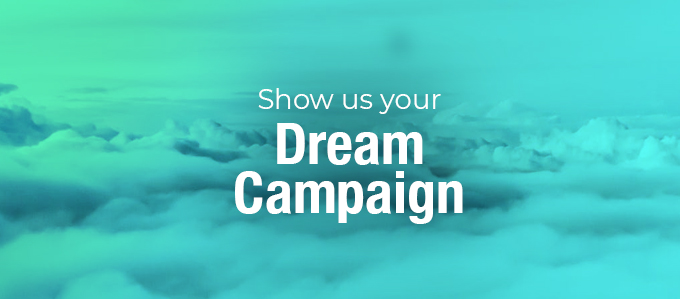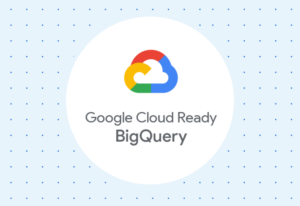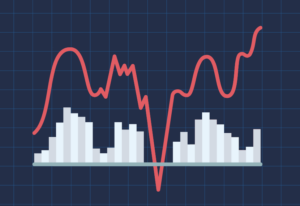If you’re an #emailgeek, odds are good there’s a dream campaign you have rattling around in your head. It’s an idea you’ve probably had for awhile, but you just haven’t quite figured out how to execute it — Maybe you don’t have access to the tools you’d need, or you haven’t sold your team on it just yet. But one day, you hope to put it into action.
We wanted to hear those stories, so we put out a call to hear about your dream email campaigns, with a promise that our favorite would win a free ticket to the Litmus Live conference in San Francisco next month. We received many terrific, passionate entries from marketers who love the power of email, and have big ideas about what they can accomplish with it.
Our winner came from LaToya Bowlah at Bloomberg. You could immediately tell that this was something she put a ton of thought and effort into mapping out. We loved the complexity and creativity of it, how it planned to take its recipients on a journey, using segmentation and personalization to create content that speaks directly to the individual receiving the email, gradually gaining their trust and loyalty leading up to the point of conversion. It’s beautifully thought out and explained. LaToya’s passion for email came through loud and clear.
You can read the full entry below. Then, keep scrolling to see some others we loved and thought deserved recognition as well. Maybe you can get some inspiration for your next campaign.
LaToya Bowlah, Bloomberg
As an email marketing manager, I am most passionate about the convergence of creativity, human psychology, and data to influence action. I have many dream campaigns I’d hope to one day bring to life.
The one described below is called Curtsy to Conversion. It is a simple story about the power of first impressions, inbox intimacy, and creating meaningful interactions that lead to relationships — told through an automated series of five emails to an audience of executives at mid-sized organizations who undervalue email marketing automation.
****
“What made you look? Was it my good looks, approachable manner, this curious subject line or a combination of all three?” Email One will deliver a clear value proposition through beautiful design and a conversational tone. It will also spark the reader’s curiosity to show (not tell) the value of a captivating first impression. The call to action (CTA) of this email will not attempt to boost traffic or make a sale — this is too self-serving for a first interaction. Instead, the CTA will be a simple interactive poll embedded in the email body that asks the audience, “What made you look?”
“I have a story to share with you. Now that I’ve caught your attention and had the pleasure of an introduction, I’d like for us to get to know each other a little better. Is this a first date, an interview perhaps, or a sales pitch?” Email Two will be all three packaged with elegance and diplomacy. How? Instead of a product breakdown or blog post outlining benefits, Email Two will embody the elements of a story and hook with a CTA to explore a case study that spotlights a tangible and relatable business scenario for scaling email automation.
“Now it’s your turn! Ever been on the receiving end of a monologue with an overzealous braggart? Did you roll your eyes, seek the fastest way out, send them to voicemail, or immediately close the email?” Email Three will do the opposite. Now that I’ve both captured the reader’s initial interest and shared an impressionable story, it’s time to nudge the reader to engage in the conversation. Email Three is a value- or data-driven alternative of the case study in Email Two. It offers richer insight in exchange for more information about the reader’s goals, concerns or challenges with email automation. This email will tout a digestible infographic with a CTA to access an in-depth report in exchange for more information.
The data collected from the readers would help to identify some key themes for segmentation and personalization. This stage of the campaign could be ongoing for sometime but will help align any further conversations to the right persona. During this stage, I would also test and iterate to increase the pool of engaged audience members.
“You can trust me with more responsibility. We’ve been talking for some time, and I believe our interests align. I want to be more than just another line in your inbox. Will you subscribe to my daily newsletter for reliable insight and inspiration into email marketing?” Email Four formalizes a trusted relationship. The engaged executives that make it to Email Four now trust me to actively educate them on the value of email marketing and will be more likely to invest in the channel’s tech and talent in the future. Based on the insight into the goals and challenges of the executives who responded to Email Three—the newsletter content would be tailored to micro segments within our current audience. For instance, those who listed budget as a challenge would receive different content from the person who listed that finding the right email tech stack was a challenge. The newsletter will also leverage FOMO to foster engagement. For instance, while engaging with the newsletter, a reader could see “1,000 people read this article already.”
And finally … “It’s OK to let your guard down. Can you think of a time when you were able to turn your vulnerability into a strength? Maybe you learned a new skill, pioneered an innovative solution or filled a talent gap.” Email Five will seal the deal. It is a straightforward yet highly targeted and thorough sales pitch that aligns a scalable solution to the challenges and vulnerabilities we know the reader has. It would convey something like this: “Based on your specific goals, challenges and interest, here is my recommendation on how we should use our email marketing program to scale business growth and deliver an X% increase in ROI.” The CTA will be to approve, deny, or modify the pitch.
****
By using the psychology behind everyday human interactions to drive the rationale behind each email, this nurture aims to spark curiosity, foster ongoing email marketing education, build a trusting relationship and ultimately secure executive buy-in to the value of an intelligent and automated email marketing program. Some KPIs for this nurture include: Was there a segment of the audience who seamlessly moved from curtsy all the way to conversion? Did the gamification elements like the embedded poll successfully engage the audience? What was the conversion rate for newsletter subscribers? How many executives actually approved the plan to scale email marketing at the end of the nurture? Are there any trends between the newsletter subscribers and the executives who approved?
Daniel Partovi, Savings.com
As an email marketer in the affiliate marketing/discount space, I dreamed of doing a campaign for Home Depot, Lowe’s, or Sears where you walk through a virtual house to see household items that the business sells.
This could either be built into the email, or (more realistically) it would direct to a page on the merchant’s website. You could even incorporate VR for mobile devices that support it. For example, if Home Depot is running a special where they have 20% off all kitchen items one month, you could do a fully immersive email where potential customers can enter a virtual kitchen. The email content would simply give a brief explanation of the process and utilize a main CTA with the text “Enter Your Kitchen.” The initial room is completely empty, and they would be able to furnish the space with all the products that are available/on sale. It would be similar to the SIMS game but with only real-life, discounted products (or all products). From there, they can see how a refrigerator looks next to a stove or how cabinet handles compare to others, all by hovering over each item with their cursor and dragging + dropping the items into the location they prefer. The price would always be listed in a similar way as an e-commerce shopping cart, and the customers can go directly to checkout.
Ideally, every action would be trackable in some fashion, and you can monitor the items that people engage with over others. Hopefully, the items get automatically moved into a cart so you could also play around with an abandonment email campaign to re-interest them.
The benefits of this type of campaign are numerous. You can set a different location and build out a new immersive and engaging experience that customers can return to. You can also see correlations between customers that are interested in certain products and how they engage with similar products, some of which customers may have never previously considered. This can help optimize your upsell feed for normal purchasing. The experience would also increase time-on-site metrics, which would help the SEO team, and engagement should be extremely high given the customer base is already-proven shoppers of the store.
Lisa Shininger, LexisNexis
This has absolutely nothing to do with the day job I have, but I’ve been dreaming about a nurture campaign to Americans between 18-29 who are eligible to vote but haven’t registered. First, we need to warm them up, so we’ll send a newsletter with CTAs that will help us hone in on the issues most important to them. There’s an article about paying down student loans, one about getting kicked off their parents’ healthcare, and three or four others. Based on the engagement data, we’ll lump them into a few key issue groups and start sending them through automation.
Second touch gives them a concrete example of how their elected officials will make their lives harder or easier around that issue, and the CTA goes to their state’s online voter registration info. For those who click through, third touch links them to a service that periodically reviews their registration status to make sure they haven’t been purged and alerts them if they have. For those who didn’t click to register, the third touch starts upping the stakes by bringing in some culturally relevant heavies (up to and including Beyoncé, natch) to make the case for voting and the CTA goes to the registration link again. If they don’t click through again, we follow up with a fourth touch where we ask them to tell us why they don’t want to register. (Maybe when they do, we can move them into another nurture stream that includes text messages or snail mail from other young voters in their area, a la Postcards to Voters, or to resources to help them deal with whatever it is that makes them think their vote won’t matter.)
For the folks who engaged with us right away and registered to vote in those first two touches, we follow up with messages encouraging them to make a voting plan, including how they can get to and from the polls around a work schedule, how they can bring others with them, and how they can stay up to date on what’s going to be on the ballot, and reminding them of key voting dates in their precinct. And of course, Beyoncé will chime back in with a “personal” video message thanking them for doing their civic duty for all of us.
Laura Eidam, NBC Sports Group
This summer, we began sending a preference-based sports newsletter three days a week that takes approximately 5 hours to build. While we are excited to have this new personalized email, we want to give our subscribers an even more personalized experience. We want to be able to target them by their favorite teams, players, etc., and give them live updates as content is created, have a dynamic schedule that updates as the game/match is occurring and so much more. We have a much different experience with email marketing since we are not selling products to our users, so we want to make sure we can target them in different ways and be able to feed them the content they want to see. Additionally, since we cover all sports in our email, we have to make sure we target each fanbase separately and learn their unique behaviors. For example, our NASCAR fans have completely different interests than our NHL fans, so we need to learn those behaviors and serve them that content. Right now, it’s a very long process to get each newsletter out, so we would love to lean more on automation to cut down the build time. But we would hope that automation would be targeted and would serve each user content we know they want.
Chandler Heida, Mutual of Omaha
I would create a “Choose your own adventure” campaign that is also a race. It would start with an email being sent to the most engaged subscribers. Those recipients would all get an email announcing that they have just been entered in (Brand Name)’s first annual email quest/race, telling them that it starts at 10am the next day, describing the “journey” they would be taking and that there are prizes for finishing quickly…something like a free ticket to Litmus for 1st place, great prizes for the 2nd-25th places, good prizes for 26th-100th places and conference swag-type prizes for 100th-250th places (ranges for each prize should probably vary based on the audience size for the race).
When the quest/race starts, each email will be interactive and pose the subscriber with a choice and two options. For example, you’re following directions on a map and come to a fork in the road. Do you “Turn Left and follow the path on your map” OR “Turn right and follow the sign labled ‘Shortcut’ that goes down dark and spooky path” with gif’s/imagery would make the subscribers feel like they’re actually making the decision? When they make their choice, the email will tell them if they chose well (immediately receiving the next email) or poorly (5-minute delay). Subsequent emails would be based on the decisions they’ve made, with all of them ultimately leading to the “finish line” or objective for the quest that was outlined in the first email. When the subscribers get to the end of the journey (approximately 5-8 emails), they would get a “Congratulations! You finished in (dynamically populated image showing where you finished)th place! Your prize is (whichever prize is associated with their finishing position).”
Once the race with the engaged subscribers is completed, I would make it publicly available and remove the race elements so that anybody could enter the journey via the website with the “prize” for completion being something like a discount code for my products.
You could make the choices in the email whatever you want, so there is no limit to what you could learn from/about the subscribers.
I am not aware of any brands interacting with their subscribers like this, so it would be a first-of-its-kind promotion, which has the potential to go viral (at least in the #EmailGeeks community) and would be sure to get people talking about the brand.






